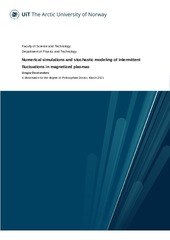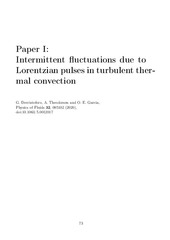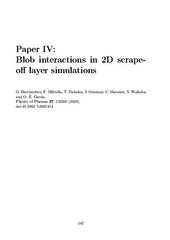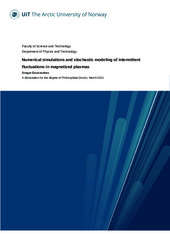| dc.contributor.advisor | Garcia, Odd Erik | |
| dc.contributor.author | Decristoforo, Gregor | |
| dc.date.accessioned | 2021-05-10T13:07:43Z | |
| dc.date.available | 2021-05-10T13:07:43Z | |
| dc.date.issued | 2021-05-21 | |
| dc.description.abstract | The exhaust of particles and heat in the boundary of contemporary magnetic confinement experiments remains to this day a major obstacle on the road to commercially viable fusion energy production. It is recognized, that coherent structures of hot and dense plasma, called blobs or filaments, are the dominant mechanism for cross-field particle transport. These filaments are created by plasma turbulence at the outboard midplane and move radially outwards driven by interchange motions. This leads to high average particle densities and relative fluctuation levels in the scrape-off layer, which increases plasma-wall interactions.
Time series of the plasma density measured at a fixed point using either Langmuir probes or gas puff imaging have shown highly intermittent fluctuations across a variety of devices, plasma parameters and confinement modes. Recent statistical analysis of measurement data time series has revealed that
the fluctuations are well described as a superposition of uncorrelated exponential pulses with fixed duration and exponentially distributed pulse amplitudes, arriving according to a Poisson process.
Due to the complexity of the physics involved in the boundary of fusion devices, numerical simulations are utilized to gain an accurate description of scrape-off layer plasmas. This approach requires a validation metric for simulations of plasma turbulence such as the statistical framework based on filtered Poisson processes. In this thesis, well-established models for scrape-off layer plasmas are analyzed. These models use two-fluid equations simulating plasma evolution in the two-dimensional plane perpendicular to the magnetic field. Time series of the plasma density are measured at a fixed point and their fluctuation statistics are compared to experimental measurements utilizing the statistical framework. This includes probability density functions, power spectral densities and conditionally averaged waveforms. In addition, simulations of a population of seeded blobs are performed in order to study the effects of blob interactions. It is shown that the fluctuation statistics of single-point measurements in simple numerical models stand in excellent agreement with their experimental counterparts. This work thereby sets a new standard and methodology for validating scrape-off layer turbulence simulations. | en_US |
| dc.description.doctoraltype | ph.d. | en_US |
| dc.description.popularabstract | The exhaust of heat and particles in the boundary of contemporary fusion experiments remains to this day a major obstacle on the road to commercially viable fusion energy production. It is recognized, that plasma turbulence is the main cause for particle transport, leading to damaging plasma-wall interactions. Due to the complexity of the physics involved in the boundary of fusion devices, numerical simulations are utilized in order to gain a better understanding of boundary plasmas. In this thesis, well-established models for fusion plasmas are analyzed. The statistical properties of these numerical simulations are validated by a stochastic model which stands in excellent agreement with experimental measurements. The presented work identifies which numerical models accurately describe boundary plasmas and thereby which models can be utilized for simulations of current and next generation fusion devices. | en_US |
| dc.description.sponsorship | My PhD position was funded directly by UiT and the Department of Physcis and Technology.
Thank you once again for giving me the opportunity to work on this interesting project in such a productive and friendly environment. | en_US |
| dc.identifier.isbn | 978-82-8236-439-3 | |
| dc.identifier.uri | https://hdl.handle.net/10037/21170 | |
| dc.language.iso | eng | en_US |
| dc.publisher | UiT Norges arktiske universitet | en_US |
| dc.publisher | UiT The Arctic University of Norway | en_US |
| dc.relation.haspart | <p>Paper I: Decristoforo, G., Theodorsen, A. & Garcia, O.E. (2020). Intermittent fluctuations due to Lorentzian pulses in turbulent thermal convection. <i>Physics of Fluids, 32</i>(8), 085102. Also available in Munin at <a href= https://hdl.handle.net/10037/21159> https://hdl.handle.net/10037/21159</a>.
<p>Paper II: Theodorsen, A., Decristoforo, G. & Garcia, O.E. Dirac comb and exponential frequency spectra in chaotic dynamics. (Manuscript).
<p>Paper III: Decristoforo, G., Theodorsen, A., Omotani, J., Nicholas, T. & Garcia, O.E. (2021). Numerical turbulence simulations of intermittent fluctuations in the scrape-off layer of magnetized plasmas. (Submitted manuscript). Also available at <a href= https://arxiv.org/abs/2102.04723>arXiv:2102.04723 [physics.plasm-ph]</a>.
<p>Paper IV: Decristoforo, G., Militello, F., Nicholas, T., Omotani, J., Marsden, C., Walkden, N. & Garcia, O.E. (2020). Blob interactions in 2D scrapeoff layer simulations. <i>Physics of Plasmas, 27</i>, 122301. Also available in Munin at <a href=https://hdl.handle.net/10037/21158>https://hdl.handle.net/10037/21158</a>. | en_US |
| dc.rights.accessRights | openAccess | en_US |
| dc.rights.holder | Copyright 2021 The Author(s) | |
| dc.rights.uri | https://creativecommons.org/licenses/by-nc-sa/4.0 | en_US |
| dc.rights | Attribution-NonCommercial-ShareAlike 4.0 International (CC BY-NC-SA 4.0) | en_US |
| dc.subject | Plasma Physics | en_US |
| dc.subject | scrape-off layer physics | en_US |
| dc.subject | Numerical simulations | en_US |
| dc.subject | 2D two-fluid turbulence simulations | en_US |
| dc.subject | Statistical analysis | en_US |
| dc.subject | Filtered Poisson Process | en_US |
| dc.title | Numerical simulations and stochastic modeling of intermittent fluctuations in magnetized plasmas | en_US |
| dc.type | Doctoral thesis | en_US |
| dc.type | Doktorgradsavhandling | en_US |


 English
English norsk
norsk



